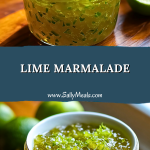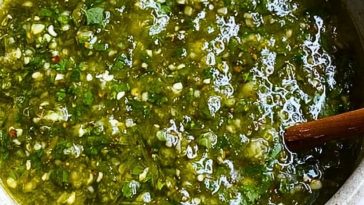I’ve always had a soft spot for zesty, bright flavors—especially when they come in the form of a spoonable treat like Lime Marmalade. This citrusy spread is like sunshine in a jar. It strikes a beautiful balance between tart and sweet, with a slight bitterness that makes it unmistakably marmalade. There’s also something incredibly satisfying about making your own preserves from scratch. Watching simple ingredients transform into something so vibrant and complex feels like a little kitchen magic.
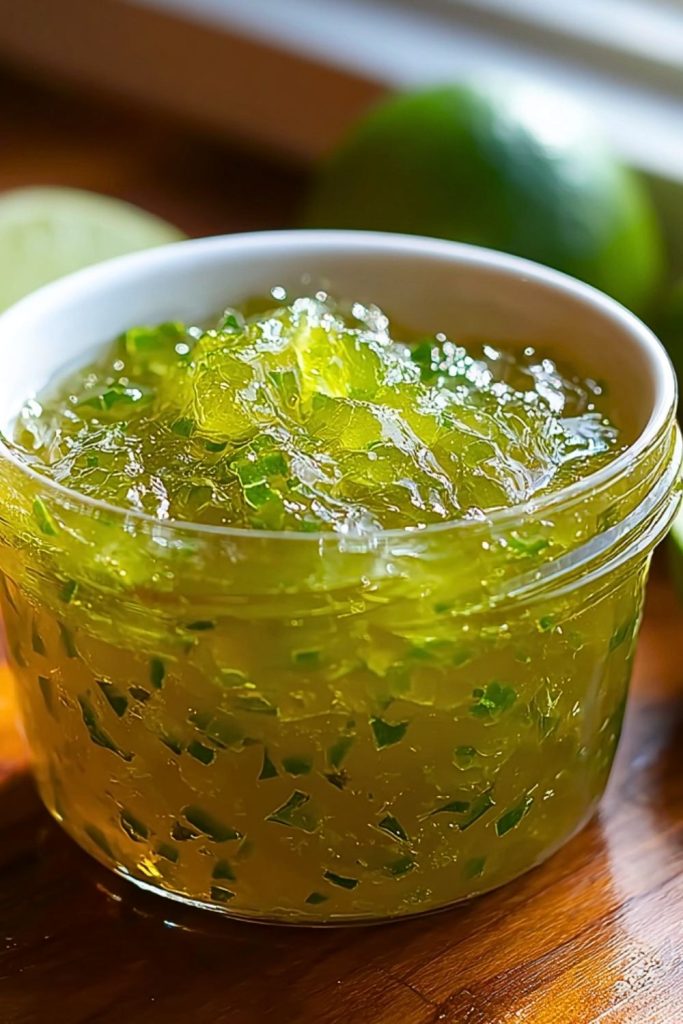
The first time I made lime marmalade, I was drawn in by its jewel-toned glow and refreshing punch of flavor. It quickly became a staple on my breakfast table and an unexpected secret weapon in savory dishes, too. Whether you’re spreading it on toast, pairing it with cheese, or using it as a glaze, this marmalade has range. And the best part? It’s easier to make than you might think, and so much more flavorful than anything store-bought.
Why You’ll Love This Lime Marmalade
This marmalade isn’t just for toast. You’ll love its versatility—equally at home on a biscuit as it is brushed over grilled chicken. The vibrant lime flavor is a refreshing twist on the classic orange marmalade, and the glossy texture makes every spoonful look like a gem. If you’re a fan of sweet-tart flavor profiles, this is a must-try. Plus, it makes a beautiful homemade gift for the citrus lovers in your life.
What Kind of Limes Should I Use for Lime Marmalade?
For the best results, I recommend using fresh, juicy Persian limes (the kind most commonly found at grocery stores). They have a nice balance of tartness and bitterness and provide a good amount of juice and zest. If you can find Key limes, you’ll get a slightly more floral and intense flavor, but they’re smaller and harder to work with. Either way, choose limes that feel heavy for their size—that’s a sign they’re full of juice.
Make sure to use organic limes if possible, especially since the zest and peel are a big part of this recipe. You’ll be eating the peel, so it’s worth seeking out fruit that hasn’t been sprayed with synthetic pesticides.
Options for Substitutions
While the core of this recipe is all about limes, there’s still some room to play:
- Lemon-Lime Combo: Swap out a portion of the limes with lemons for a slightly sweeter, mellow flavor.
- Grapefruit or Orange Peel: Add strips of grapefruit or orange peel for a complex citrus blend.
- Honey instead of Sugar: For a richer, more floral sweetness, replace up to half the sugar with honey (note: this may slightly affect the setting).
- Pectin-Free: This recipe typically doesn’t need added pectin, but if you want a firmer set or are cutting back on sugar, low-sugar pectin can help.
- Herbal Twist: A sprig of rosemary or a few basil leaves added during simmering (then removed) can add an unexpected savory note.
These variations can give your lime marmalade its own unique flair while keeping that signature citrus brightness front and center.
Ingredients for This Lime Marmalade
- Fresh Limes
The star of the show. You’ll need both the juice and the peel for that bold, tangy, slightly bitter marmalade flavor. Choose limes that are firm yet give slightly when pressed. - Granulated Sugar
Essential for sweetening the marmalade and helping it gel properly. It also balances out the tartness of the lime and contributes to that glossy, jammy texture. - Water
Used to simmer the lime peels and extract their flavor. It’s the base that helps everything meld together smoothly. - Optional: Pectin (if needed)
Many lime marmalade recipes gel well naturally thanks to the lime peel’s natural pectin, but if your batch needs help setting, commercial pectin is a helpful backup.
These basic ingredients create something far greater than the sum of their parts—bright, sharp, and delicately bitter with just the right amount of sweetness.
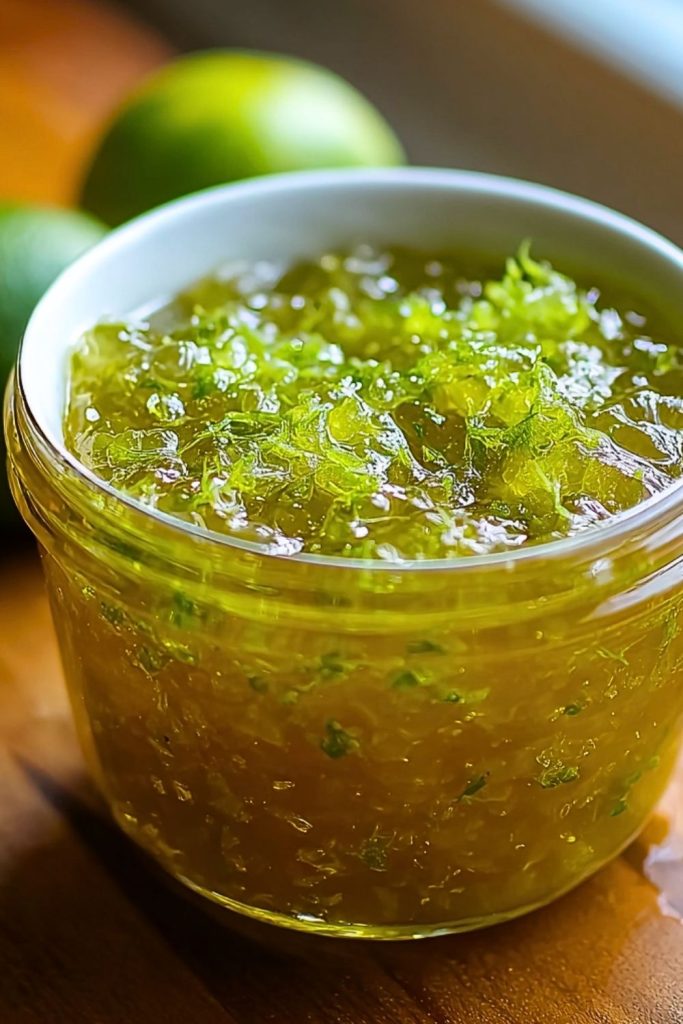
Step 1: Prepare the Limes
Wash the limes thoroughly, especially if you’re not using organic. Slice them in half lengthwise, then into very thin half-moon slices. Remove and discard any seeds. If you prefer a smoother marmalade, you can finely chop the slices after this step.
Step 2: Soak the Lime Slices
Place the sliced limes in a large pot and cover with water. Let them soak for at least 4 hours—or overnight if you want a more mellow bitterness. This step softens the peel and reduces harshness.
Step 3: Simmer the Citrus
Bring the soaked limes and water to a boil, then reduce the heat and simmer uncovered for 30–40 minutes until the peel is tender and the mixture has reduced slightly.
Step 4: Add the Sugar
Measure the cooked lime mixture and add an equal amount of sugar by volume. Stir well and return the pot to the stove. Bring the mixture to a boil over medium-high heat, stirring frequently to prevent burning.
Step 5: Cook Until It Sets
Continue boiling the marmalade until it reaches the setting point—about 220°F (104°C) on a candy thermometer. This can take 20–30 minutes. To test without a thermometer, place a small amount on a chilled plate. If it wrinkles when pushed, it’s ready.
Step 6: Jar the Marmalade
Carefully ladle the hot marmalade into sterilized jars, leaving ¼ inch of headspace. Wipe the rims clean, seal with lids, and process in a boiling water bath for 10 minutes if you plan to store long-term.
How Long to Cook the Lime Marmalade
The entire cooking process—from simmering the lime peels to reaching the gel point—takes about 60 to 90 minutes total. Here’s the breakdown:
- Initial simmer (after soaking): 30–40 minutes to soften the rinds.
- Final boil with sugar: 20–30 minutes, depending on your batch size and moisture.
Always monitor closely during the final boiling stage—once the marmalade reaches its setting point, it can go from perfect to overcooked quickly.
Tips for Perfect Lime Marmalade
- Slice the peel evenly: Thin, uniform slices cook more consistently and create a better texture.
- Use a candy thermometer: It’s the easiest way to ensure your marmalade gels perfectly without overcooking.
- Chill test a few drops: Drop some marmalade onto a frozen plate—if it wrinkles when pushed, it’s set.
- Stir constantly near the end: As it thickens, sugar can burn quickly at the bottom of the pot.
- Sterilize your jars properly: If you plan to store it for more than a few weeks, clean jars and a water bath seal are essential for safety.
- Don’t skip the soaking: This step is crucial to mellow the bitterness and soften the rind for a tender texture.
Watch Out for These Mistakes While Cooking
- Overcooking the Marmalade: Once the marmalade reaches the setting point, it’s easy to overcook, which can result in a hard, candy-like texture. Keep a close eye on it during the final boiling stages.
- Not Testing for Set: Relying solely on the thermometer can sometimes be misleading. Always check for the gel consistency by using the cold plate test, as temperatures can vary.
- Skipping the Soaking Step: The soaking process helps reduce the bitterness of the lime peel. If you skip it, your marmalade might end up too bitter and not as mellow in flavor.
- Underestimating the Storage Process: If you’re canning your marmalade, it’s important to ensure your jars are properly sterilized and sealed to avoid spoilage.
What to Serve With Lime Marmalade?
1. Butter Biscuits
Flaky, buttery biscuits are the perfect vehicle for this tangy marmalade. Spread a generous layer of lime goodness over a warm biscuit for a delightful breakfast or snack.
2. Cream Cheese on Toast
Lime marmalade pairs beautifully with cream cheese on toasted bread. The creaminess of the cheese balances the tartness of the marmalade perfectly.
3. Cheese Platters
This marmalade is a fantastic addition to any cheese board. It pairs especially well with sharp cheeses like aged cheddar, goat cheese, or brie.
4. Pancakes or Waffles
For a unique twist on your typical breakfast spread, serve lime marmalade as a topping for pancakes or waffles. The bright citrus flavor adds a fresh zing to the meal.
5. Roasted Meats
Brush lime marmalade on roasted chicken, pork, or duck for a sweet-tart glaze that complements the savory flavors of the meat.
6. Scones
Pair it with a classic British scone and a cup of tea for a light, elegant treat. The citrusy marmalade adds a refreshing element to the richness of the scone.
7. Ice Cream
Lime marmalade is also an unexpected but delightful topping for vanilla or coconut ice cream. Its sweet-tart nature is the perfect contrast to the creamy ice cream.
8. Yogurt Parfaits
Swirl a spoonful of lime marmalade into Greek yogurt, then layer with granola and fresh fruit for a refreshing breakfast or snack.
Storage Instructions
Once your lime marmalade is ready and cooled, store it in airtight jars. If you’ve canned it in a water bath, it can be kept in a cool, dark place for up to a year. For marmalade stored in regular jars without processing, refrigerate it, and it will stay fresh for about 3–4 weeks.
Make sure to use sterilized jars to prevent any bacterial contamination, and always check the seal before storing long-term. If you notice any mold or off smells, discard the jar.
Estimated Nutrition
Here’s an approximate breakdown for one tablespoon (about 20 grams) of homemade lime marmalade:
- Calories: 50
- Fat: 0g
- Sodium: 0mg
- Carbohydrates: 13g
- Fiber: 0g
- Sugar: 12g
- Protein: 0g
- Cholesterol: 0mg
Since lime marmalade is primarily sugar and fruit, the main nutritional factor is its carbohydrate content from the sugar. This treat is meant to be enjoyed in moderation as a sweet spread or topping.
Frequently Asked Questions
How long will the marmalade last in the fridge?
Homemade lime marmalade will stay fresh in the fridge for about 3–4 weeks. If you’ve canned it properly, it can last up to a year when stored in a cool, dark place.
Can I use a different type of citrus for this marmalade?
Yes! You can substitute limes with lemons, oranges, or even a mix of citrus fruits for a unique twist. Just keep in mind that each citrus will change the flavor profile slightly.
Can I make this marmalade with less sugar?
You can reduce the sugar, but be aware that the marmalade may not set as firmly without the full amount of sugar. Alternatively, you could try using low-sugar pectin to help the marmalade set with less sugar.
What’s the best way to check if the marmalade has set properly?
The easiest method is the cold plate test. Place a small spoonful of marmalade on a chilled plate, then push it with your finger. If it wrinkles and doesn’t run, it’s ready. Alternatively, use a candy thermometer—the setting point is about 220°F (104°C).
Do I need to sterilize jars for this recipe?
Yes, it’s important to sterilize jars if you plan to store the marmalade long-term, especially if you’re canning it. Clean jars and lids should be boiled for about 10 minutes to ensure they’re free of bacteria.
Can I skip the pectin?
For most lime marmalade recipes, pectin is not required because the lime peel naturally contains pectin. However, if you prefer a firmer marmalade, you can add a little commercial pectin. Be sure to follow the package instructions.
How do I fix runny marmalade?
If your marmalade didn’t set as expected, return it to the heat and simmer for a few more minutes until it thickens. You can also add a bit more pectin, but be cautious—it can change the flavor.
Can I use honey or another sweetener instead of sugar?
Yes, you can use honey, agave, or maple syrup in place of granulated sugar. Keep in mind that this will slightly affect the flavor, and the marmalade may not set as firmly, especially if you’re not using pectin.
Conclusion
Making your own lime marmalade is one of the simplest yet most rewarding things you can do in the kitchen. With its balance of tangy, sweet, and slightly bitter notes, it’s perfect for so many uses, whether it’s on toast, paired with cheese, or even as a glaze for meats. The process is straightforward, and once you get the hang of it, you can experiment with different citrus fruits or flavorings to create a marmalade that’s uniquely your own. The best part? You’ll never want to go back to store-bought once you’ve tasted the homemade version!
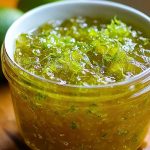
Lime Marmalade
- Prep Time: 15 minutes
- Cook Time: 60–90 minutes
- Total Time: 75–105 minutes
- Yield: 4 jars (8 oz each) 1x
- Category: Preserve / Spread
- Method: Canning
- Cuisine: American
Description
This zesty Lime Marmalade is a delightful spread that perfectly balances tart and sweet flavors. Whether you’re slathering it on toast, pairing it with cheese, or using it as a glaze, this marmalade is sure to brighten any dish.
Ingredients
6 large fresh limes
4 cups granulated sugar
4 cups water
1 tablespoon pectin (optional, for firmer marmalade)
Instructions
1. Wash the limes thoroughly, slice them in half, then cut into thin half-moon slices, removing any seeds.
2. Place the sliced limes in a large pot and cover with water. Soak for at least 4 hours or overnight.
3. After soaking, bring the limes and water to a boil. Lower the heat and simmer uncovered for 30-40 minutes until the peel is tender.
4. Measure the cooked lime mixture, then add an equal amount of sugar by volume. Stir well and bring to a boil over medium-high heat, stirring frequently.
5. Continue to boil the marmalade until it reaches the setting point (220°F or 104°C on a candy thermometer) or until it wrinkles on a chilled plate.
6. Ladle the marmalade into sterilized jars, leaving about ¼ inch of headspace. Seal the jars and process in a boiling water bath for 10 minutes for long-term storage.
7. Let the jars cool, then store in a cool, dark place or refrigerate for up to 4 weeks.
Notes
Prep Time: 15 minutes
Cooking Time: 60–90 minutes
Yield: About 4 jars (8 oz each)
Category: Preserve / Spread
Nutrition
- Serving Size: 1 tablespoon
- Calories: 50
- Sugar: 12g
- Sodium: 0mg
- Fat: 0g
- Saturated Fat: 0g
- Unsaturated Fat: 0g
- Trans Fat: 0g
- Carbohydrates: 13g
- Fiber: 0g
- Protein: 0g
- Cholesterol: 0mg

